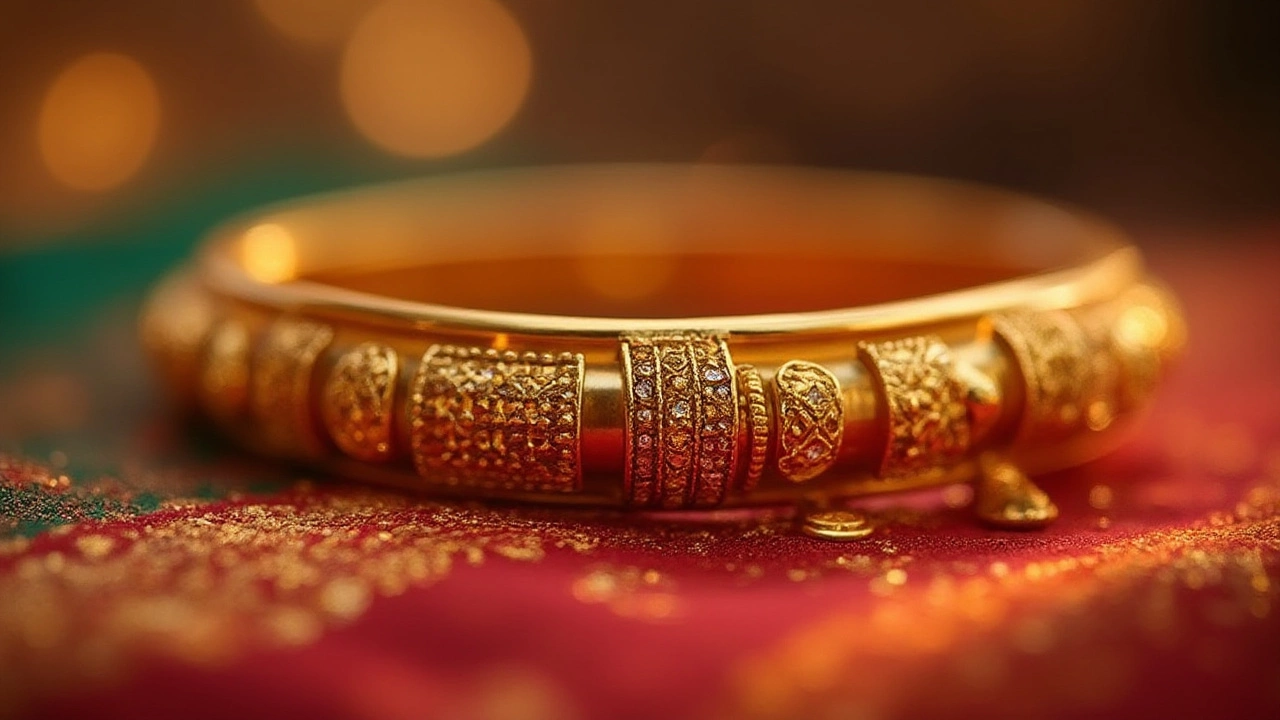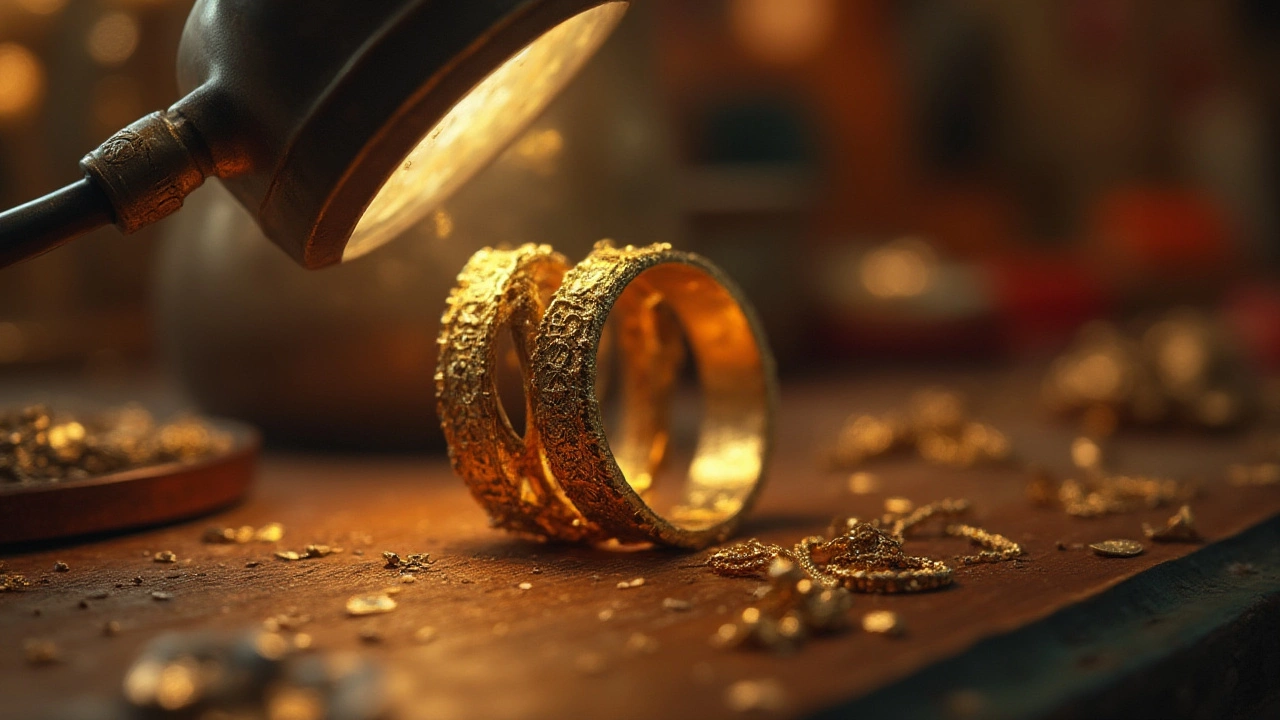
Ever come across a shiny gold ring or necklace and spot the numbers "750" stamped in a tiny, neat font? That little number packs a punch in the world of jewelry. For many, jewelry markings seem like cryptic codes—random numbers, letters, odd shapes. But knowing what "750" means helps you spot real value and avoid costly mistakes. Whether you're buying, selling, or inheriting gold, there's a lot riding on these small digits.
What Does the 750 Stamp Actually Mean?
That "750" stamp is no random scribble: it’s a precise indicator of gold purity. Instead of simply saying “this is gold,” jewelers use hallmark numbers to tell buyers how much gold is in the metal mix. A 750 marking means that the object is 18 karat gold. Here’s how that works:
| Karat | Gold Percentage | Stamp Example |
|---|---|---|
| 24K (Pure Gold) | 99.9% | 999 |
| 22K | 91.7% | 917 |
| 18K | 75.0% | 750 |
| 14K | 58.5% | 585 |
| 10K | 41.7% | 417 |
The rest of the piece—the other 25%—is made of other metals mixed in to give it strength and color. Gold in its pure (24K) form is actually too soft for most jewelry. You'd bend your gold ring just by gripping a door handle. That's why jewelers mix in a bit of copper, silver, or even a touch of nickel. The "750" code is widely used in Europe, the Middle East, and parts of Asia, so don’t be surprised to see it stamped alongside local hallmarks or logos. In the U.S., "18K" is more common, but the 750 number is easily understood by any pro in the field.
What does this mean in real life? If you ever get a bracelet or ring with a "750" hallmark, you can bank on the fact that it contains 75% real gold. Among all standard gold alloys, 18k (750) strikes the best balance between value and practicality—rich color, impressive purity, but tough enough for daily wear. That makes it more valuable than 14k (which is only 58.5% gold), and less precious—but definitely sturdier—than 24k (99.9% gold). Many high-end brands, including Cartier and Bulgari, often use 18k gold for exactly this reason.
Next time someone flashes an "18K" or "750" bracelet, you’ll know it contains three-quarters pure gold. No smoke and mirrors. That’s the truth stamped right into the metal.

Why Is 750 Gold So Popular? The Perks and Pitfalls
So, why does 750 gold get so much love? It all comes down to three big factors: color, durability, and resale value. First off, let’s talk about color. 18k gold has a deep, warm glow—almost the perfect golden hue most of us imagine. That’s because it’s got enough pure gold to really shine, but not so much that it looks yellow-orange or brassy. You’ll see this beautiful gold used in engagement rings, wedding bands, statement necklaces, and more. Unlike 14k or 10k, which can sometimes appear paler or slightly faded, 750 gold just pops against the skin.
Durability is next. Pure gold is malleable—it dents, scratches, and bends way too easily for rough-and-tumble life. Not ideal if you’re the hands-on type. The metals blended into 18k gold give it enough backbone to survive regular wear, but without dulling that signature shine. For someone looking for lifelong keepsakes—something to hand down to the grandkids—750 gold is a sweet spot. It won’t go green on your wrist. It won’t flake. Care for it, and it’ll keep its glow for generations.
Jewelry collectors and investors know another secret: 750 gold holds its value well. Since you’re getting a high gold content, resale prices reflect that, especially compared to 14k or lower. Let’s say gold prices rise sharply (like we saw in recent years). Buyers and traders look for marks like “750” because that tells them, right away, that a piece has genuine weight—quite literally—for melting or resale. Next time you walk past a pawn shop, check out what they’ll pay for 18k versus 14k. Often, it’s as much as 30% higher.
Here’s something to keep in mind: not all 750-marked jewelry is made equally. Some fakes out there try to mimic the stamp. An authentic 750 hallmark should usually come with additional marks—a manufacturer’s symbol, country stamp, or assay office logo. If it’s just "750" alone in a clumsy engraving, watch out; you might be looking at gold plating, not a real solid gold alloy.
On the flip side, 750 gold isn’t invincible. If you have severe allergies to certain metals, pay attention to what that other 25% is made of. Nickel, for example, is a common allergen found in low-cost mixes. That’s why premium brands list the alloy—usually pairing gold with silver, copper, or palladium. If you’re after rose or white gold, 18k is often the sweet spot. Rose gold gets its blush from higher copper, white gold from palladium or nickel. The “base” is still 75% pure gold by weight. But if you see any dark discoloration or feel irritation, don’t ignore it—your skin’s telling you something about the alloys used.
Ever heard about "gold fraud" or scams involving gold jewelry? 750 stamps are a favorite target for counterfeiters. Gold-plated brass or cheap alloys get stamped with "750" in dodgy markets all the time. What stops most buyers from getting burned? A simple acid test or a visit to a reputable jeweler. Serious dealers measure the item’s density, check for real hallmarks, and may even X-ray test (yep, that’s a thing now). When in doubt, always buy from established jewelers or get a second opinion before shelling out cash.
So, whether you love the glow, want lasting value, or fancy a piece that’ll last through thick and thin, 750 gold checks all the right boxes for most folks. Not too soft, not too hard—just right.

Pro Tips for Buying, Selling, and Spotting 750 Gold Jewelry
Stepping into the world of gold jewelry can feel overwhelming, especially with so many marks, myths, and marketing tricks. If you’re serious about getting a piece with real value, here are practical tips and tricks you won’t hear from the average salesperson:
- Trust but verify: Not every "750" mark is legit. Always check for a secondary hallmark, like a tiny logo or country stamp. If a piece only has "750" stamped in a wonky way, that’s a red flag.
- Weight matters: Feel the weight in your hand. Gold is dense; cheap fakes usually feel too light for their size.
- Test the color: 18k gold won’t react with oxygen, so it won’t tarnish or darken (if cleaned properly). If you notice funny colors, it might be fake or have a high copper alloy.
- Ask about alloys: If you’ve had skin reactions, find out exactly what’s mixed with the gold. Premium jewelers can tell you if there’s nickel or not.
- Get an independent appraisal: Especially if you’re buying or inheriting expensive pieces. Professional appraisers use acid tests and high-tech gadgets to tell if it’s truly 750 gold.
- Check the price per gram: Compare the piece’s price to the actual gold value based on weight and the current gold market rate. Remember, 18k gold contains 75% real gold by mass. If someone’s selling you an “18k” bracelet for next to nothing, something’s fishy.
- Maintain your investment: Store 750 gold pieces separately, ideally wrapped in soft cloth. Harsh chemicals, like those in bleach or chlorine pools, can discolor alloys or weaken the metal. A gentle rub with a clean, soft cloth keeps your jewelry looking new.
Ready to spot a 750-marked piece yourself? Here’s a step-by-step:
- Look closely at the inner band, clasp, or tag of the jewelry for the hallmark. Use a magnifying glass if needed.
- If you see “750,” check for extra hallmarks: country codes (like “ITALY” or “FR”), trademark logos, or a maker’s mark that looks like a tiny symbol or initials.
- Weigh the piece. Most jewelers can do this for you. Remember: gold is heavy—even a small ring should feel substantial.
- If you can, do an acid test. Many jewelers offer free or small-fee testing. A drop of acid on a tiny scratch reveals the metal’s authenticity (don’t try this at home unless you know how—it can damage the finish).
- If you’re unsure, swing by a certified jeweler or independent appraiser. They’ll tell you if it’s real gold, plated, or a blend.
Remember, 750 jewelry isn’t just about that number. Knowing its story means knowing what you’re really holding—nearly pure gold, carefully balanced for everyday life. You don’t need a degree to spot quality; just curiosity, some common sense, and these tricks. And hey, every time you spot a “750” stamp from now on, you’ll know there’s real value there—more than meets the eye.


